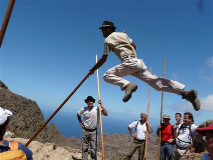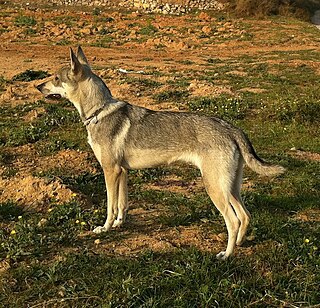This article needs additional citations for verification .(October 2019) |

The shepherd's leap (Spanish : Salto del pastor) is a folk sport practised throughout the Canary Islands.
This article needs additional citations for verification .(October 2019) |

The shepherd's leap (Spanish : Salto del pastor) is a folk sport practised throughout the Canary Islands.
The origins of salto del pastor may date back to the Guanches, the aboriginal inhabitants of the islands prior to the Castilian conquest period of the early 15th century. Canarian shepherds required a specialised means of transporting themselves safely across ravines and down steep embankments, and settled on the use of long wooden poles known as lanza or garrote. These poles are fitted with sharp metal points called regatón.
Salto del pastor practitioners have developed a wide range of techniques to facilitate quick and agile movement across extremely difficult and dangerous terrain. These techniques range from pole-vaulting across crevices to the "dead drop" in which the practitioner leaps into space from heights of up to eight metres, jamming their garrote into the ground below and then sliding down the pole. There are many other types of leaps, depending on the nature of the obstacle that needs to be cleared. Some of these are so fraught with risk that they have given rise to beautiful legends, such as the salto del enamorado (lover's leap) and the salto de media luna (half moon leap).
As salto del pastor has now developed into a folk-sport, the garrote is also used in competitive events, which include climbing up and jumping over walls, speedy descents down steep rocks, precision leaps, acrobatic feats and leaps of various
The lance of the shepherd is part of the iconographic attributes of Saint Peter of Saint Joseph de Betancur, who is the first saint of the Canary Islands. This is because said Saint was a pastor or peasant before becoming a missionary in Guatemala. [1]

The Canary Islands, also known informally as the Canaries, is a Spanish archipelago in the Atlantic Ocean, in a region known as Macaronesia. At their closest point to the African mainland, they are 100 kilometres west of Morocco. They are the southernmost of the autonomous communities of Spain, and are located in the African Tectonic Plate. The archipelago is economically and politically European, and is part of the European Union.

La Gomera is one of Spain's Canary Islands, located in the Atlantic Ocean off the coast of Africa. With an area of 370.03 km2 (142.87 sq mi), it is the third smallest of the eight main islands of this archipelago. It belongs to the province of Santa Cruz de Tenerife. La Gomera is the third least populous of the eight main Canary Islands with 22,426 inhabitants. Its capital is San Sebastián de La Gomera, where the cabildo insular is located.

Tenerife is the largest and most populous island of the Canary Islands. It is home to 43% of the total population of the archipelago. With a land area of 2,034 square kilometres (785 sq mi) and a population of 966,354 inhabitants at the end of 2020, it is also the most populous island of Spain and of Macaronesia.
Bettencourt is a surname and noble family of Norman origin. The head of the family in the 14th century, Jean de Béthencourt, organized an expedition to conquer the Canary Islands, resulting in his being made King of the Canary Islands. Though the royal title would be short-lived, it allowed the family to firmly establish itself afterwards in the Azores and Madeira islands. The family is one of the most expansive and established families of the Portuguese nobility, as well as the Spanish nobility

Juego del palo is a traditional martial art/folk sport of stick-fighting practiced in the Canary Islands. It involves the combative use of a slender stick from 4 to 6 feet long, wielded in both hands, and characterised by fluid motion in attacks and defences.

Vilaflor is a municipality and a village in the south-central part of the island of Tenerife, one of the Canary Islands, and part of the Santa Cruz de Tenerife (province), Spain. Vilaflor, with an altitude of 1,400 m, is the highest village of Tenerife, situated south the Teide volcano. It is located 7 km north of San Miguel de Abona and 51 km southwest of the island's capital Santa Cruz de Tenerife. The population is 1,645 (2018) and the area is 56.26 km².

San Sebastián de La Gomera is the capital and a municipality of La Gomera in the Canary Islands, Spain. It also hosts the main harbour. The population was 8,699 in 2013, and the area is 113.59 square kilometres (43.86 sq mi).

Peter of Saint Joseph de Betancur y Gonzáles (Spanish: Pedro de San José de Betancur y Gonzáles, March 21, 1626 – April 25, 1667, called Hermano Pedro de San José Betancurt or more simply Peter de Betancurt, Hermano Pedro, Santo Hermano Pedro, or San Pedro de Vilaflor, was a Spanish saint and missionary in Guatemala. Known as the "Saint Francis of Assisi of the Americas", he is the first saint native to the Canary Islands, is also considered the first saint of Guatemala and Central America for having done his missionary work in those American lands. He was the founder of Order of Our Lady of Bethlehem.
Canary Islanders, or Canarians, are a Romance people and ethnic group. They reside on the Canary Islands, an autonomous community of Spain near the coast of northwest Africa, and descend from a mixture of Spanish settlers and aboriginal Guanche peoples. Genetics shows modern Canarian people to be a mixture of mostly European, with significant North African, and minor Sub-Saharan African. The distinctive variety of the Spanish language spoken in the region is known as habla canaria or the (dialecto) canario. The Canarians, and their descendants, played a major role during the conquest, colonization, and eventual independence movements of various countries in Latin America. Their ethnic and cultural presence is most palpable in the countries of Uruguay, Venezuela, Cuba, the Dominican Republic, and the United States territory of Puerto Rico.

The Roman Catholic Diocese of San Cristóbal de La Laguna, also called Diocese of Tenerife or Diocese Nivariense, is a diocese located in the city of San Cristóbal de La Laguna in the Canary Islands in the Ecclesiastical province of Sevilla in Spain. The diocese includes the islands of Tenerife, La Palma, La Gomera and El Hierro, in the province of Santa Cruz de Tenerife. The bishop of this diocese is Bernardo Álvarez Afonso.

On the island of Tenerife, in the Canary Islands, many sports are practiced, both outdoors and indoors in the various facilities available throughout the island.

The Cave-Shrine of Santo Hermano Pedro, is a Roman Catholic cave-shrine dedicated to Saint Peter of Saint Joseph Betancur. It is located in the municipality of Granadilla de Abona, near El Medano on the south of the island of Tenerife, at the end of the Tenerife South Airport runway.

Betancuria is a small town and a municipality in the western part of the island of Fuerteventura in the Province of Las Palmas, Canary Islands, Spain. The population is 811 (2013), and the area is 103.64 km2 (40 sq mi). It is situated in a mountainous region, 4 km (2 mi) west of Antigua and 21 km (13 mi) southwest of the island capital Puerto del Rosario. By population it is the smallest municipality in Fuerteventura as well as all of the Canary Islands.

The Sanctuary of the Santo Hermano Pedro is a pilgrimage temple located in the town of Vilaflor, south of the island of Tenerife. The shrine is dedicated to Saint Peter of Saint Joseph Betancur, the first Saint of the Canary Islands.
Canarian Americans are Americans whose ancestors came from the Canary Islands, Spain. They can trace their ancestry to settlers and immigrants who have emigrated since the 16th century to the present-day United States. Most of them are descendants of settlers who emigrated to Spanish colonies in the South of the modern US during the 18th century. The Canarians were among the first settlers of the modern United States; the first Canarians migrated to modern Florida in 1569, and were followed by others coming to La Florida, Texas and Louisiana.

The Lobito Herreño or Perro de Pastor Herreño is a Spanish breed or type of pastoral dog. It is found mostly on the island of El Hierro in the Canary Islands, but also on Gran Canaria, La Palma and Tenerife. It is not recognised as breed by the Real Sociedad Canina de España, but in 2021 was one of three breeds or types listed as a grupo étnico canino, which the society defines as a regional dog population with consistent form and function evolved through functional selection. The other two dogs in this group are the Podenco Orito Español and the Carea Castellano-Manchego.

The fight stick is a folk sport practised throughout the Canary Islands.
As in the rest of Spain, the majority religion in the Canary Islands is the Catholic Church. The Catholic religion has been the majority since the Conquest of the Canary Islands in the fifteenth century. This religion would largely replace the Canarian aboriginal religion through the prohibition of the latter and syncretism. According to a survey conducted in 2019, Canary Islands is the fifth autonomous community in Spain with the highest percentage of people who declare themselves to be Catholics after the Region of Murcia, Extremadura, Galicia, Aragon, and Castile and León. 76.7% of the population is Catholic.